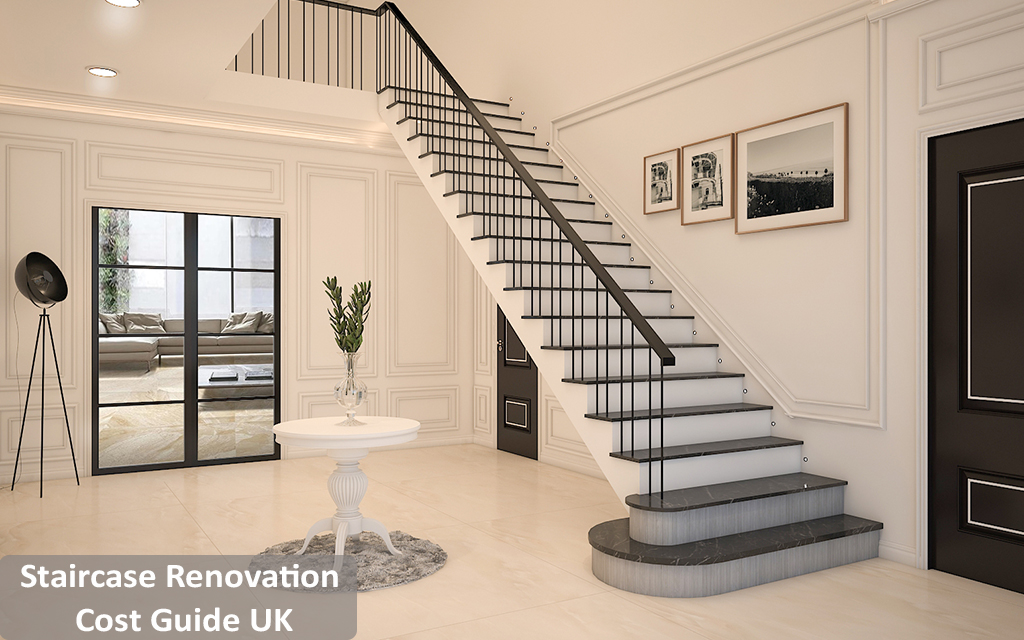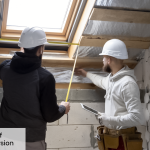How much does it cost to renovate staircase – A staircase renovation is like a refreshing breeze. It improves the staircase’s safety, looks and accessibility. Have you ever remoulded your steps? Does your staircase make a sound when you walk? Then staircase remodeling is the only best action you can take now. Today we will learn about the cost of a staircase makeover and what factors influence it.
Staircase Renovation Cost
How Much Cost for a Staircase Refurbishment in the UK?
The cost of repairing a staircase involves many components. The price is decided according to their cost. It is highly affected by the layout of the staircase, the size of the landings, the newel posts, and turns. We have broken down each aspect that is involved in a stair restoration:
- New Staircase Renovation Cost: If you are removing an old staircase and entirely transforming it, expect to pay around £1700. For a custom stair case improvement service, the price can drastically increase. It is influenced by the stair size, materials, style and labour cost.
- Labour Cost for a Stair Upgrade Job: The majority of people neglect to consider labour costs. The best staircase remodelling experts provide their labour. For your general information, the labour costs are around approx. £50- £90 per day. If your location is far; the cost can change. This labour is used for lifting heavy goods, material moving and all jobs that do not require a particular skill.
- Staircase Makeover Painter Cost: To paint a small staircase the labour can cost around £20-£30 per hour. Painters cost around £160- £300 per day. The cost varies depending on expertise and the company’s standards.
- Skirting Boards Paint Cost: The painting staircase is sometimes extended to painting the skirt-boards. It provides a complete look to the stairs overhaul. Since the job requires great attention, care and time; the cost can be higher. It is determined by the painter/ labourer itself. Typically for a skirting board in a room of 3m X 3m, it costs around £215.
Have a quick look at the average costs of a carpenter per day, carpet per staircase, new spindles, bannisters, and painting & decoration costs. It is the cost for basic installation while for advanced fittings or customized designs; it can change.
| Aspects |
Average Cost (Approximate) |
| Carpenter |
£250 (per day) |
| Carpet |
£90 (for a single staircase) |
| New spindles |
£85 |
| Bannisters |
£90 |
| Painting & decoration |
£180 |
It is important to know that these costs are estimated values. Talk to an expert staircase renovation company to know the cost price in the UK.
How Renovation of Staircase Cost is Influenced?
The cost of stair revamping depends on several factors. But note that the cost can all change if the staircase needs repairing more than expected.
- Choice of Materials: The materials used for a staircase refurbishment significantly affect its cost. The main materials used are metals, hardwood, and glass. Generally, hardwoods are more costly than other types. But it also depends on the size of the staircase and the quality of materials.
- Design of Staircase: There are several staircase designs. Each style has its unique cost price. A stair spiral is more expensive than a straight stair. However, if the straight staircase is designed of premium materials and the spiral is of basics; the cost will surprise you. So, it all comes down to the staircase designs. Other styles are half-turn, quarter-turn, curved stairs, L-shaped and floating staircases.
- Your Accessibility/ Location: Are you easily accessible to the staircase renovation company team? If you live in an area that brings transportation challenges, it can increase costs. Also, for urban areas, if you live in high-rise buildings; the access would be harder. It will again influence the staircase remodelling cost.
- Building Regulations and Permit Costs: It ensures that the staircase remodel design is safe and robust. For minor changes, this legal work is not required. For complete staircase renovation, it is crucial to check with your expert stair case refurbishment service provider, Generally, consider a roughly budget of around £250 for this.
- Duration for Stair Case Upgrade Service: Another factor influencing the stair revamp cost is the project timeframe. An urgent project needs fast work, quick decisions and overtime labour. Thus, you will have to pay more for it. While a relaxed project can expect competitive costs from the stair case design experts.
- Additional Accessories: The cost is highly influenced if you add decorating elements. For instance, lighting, area rugs, under-step storage solutions, nosing, skirting boards, anti-slip surfaces and any customization. It incorporates the sense of life into the outcome. So, get ready to pay a little more if you want these changes in your staircase renovation design.
Staircase Renovation Cost for Different Staircase Materials
For a staircase renovation in wooden material, the average cost can vary between £400-£6500. Different types of wood such as walnut, pine, oak, maple, hickory etc. have distinctive costs. A glass staircase renovation will cost around approximately £2500-£15000 and more. For a metal stair restoration, the estimated cost can go anywhere between £1500-£12000. If glass stair remodelling services are customized and combined with other elements, expect higher costs. For a cantilevered or helical staircase, the average cost can range between £15,000 to £25,000.
Experts for Staircase Renovations in the UK
Transforming steps can provide a statement look to an old stair. For the precise cost estimation of a stair case restoration project in the UK, it is always best to contact the local staircase design contractors. They will quote a specific amount depending on your unique requirements. TEL Constructions offers the best staircase remodelling services in the United Kingdom at reasonable costs. Our in-house team handles every minor to major job perfectly. They are well-trained and disciplined. We design 3d staircase renders to showcase clients the outcome. It brings satisfaction and design improvement. Want to know more about our best staircase designing & renovation services? Get in touch right away…! Our experts will be happy to assist you.
 19 December 2025
19 December 2025 19 December 2025
19 December 2025 19 December 2025
19 December 2025 19 December 2025
19 December 2025 19 December 2025
19 December 2025



mangat